US Electric Vehicle Battery Recycling Market Summary
The US Electric Vehicle Battery Recycling market is poised for substantial growth, reaching 3240 USD Million by 2035.
Key Market Trends & Highlights
US Electric Vehicle Battery Recycling Key Trends and Highlights
- The market is valued at 458.4 USD Million in 2024, indicating a strong foundation for future expansion.
- Projected growth shows a compound annual growth rate (CAGR) of 19.46% from 2025 to 2035, reflecting increasing market interest.
- By 2035, the market is expected to expand to 3240 USD Million, highlighting the rising demand for recycling solutions.
- Growing adoption of electric vehicles due to environmental concerns is a major market driver for battery recycling initiatives.
Market Size & Forecast
| 2024 Market Size | 458.4 (USD Million) |
| 2035 Market Size | 3240 (USD Million) |
| CAGR (2025-2035) | 19.46% |
Major Players
Battery Resourcers, Aqua Metals, Talon Metals, Dynamic Battery Solutions, American Battery Technology Company, Retriev Technologies, EcoGraf, Glencore, Cirba Solutions, LiCycle, Northvolt, Umicore, Redwood Materials, EV Battery Recycling

















